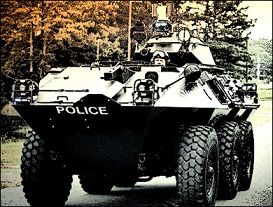By the Numbers: How Dangerous Is It to Be a Cop?by DANIEL J. BIERThe Freeman Aug. 21, 2014 |
Popular 
Rabbi Tells Senate Hearing It's 'Not Enough' to Be 'Not Anti-Semitic' - 'One Must Be Anti-Anti-Semitic'

Trump's 'Liberation Day' Includes Slapping 17% Tariff on Israel

Randy Fine Wins Florida House Race After Trump, GOP Scrambled to Prop Up His Campaign

Sen. Schumer: 'My Job is to Keep the Left Pro-Israel'

Trump Threatens War With Iran If No Nuclear Deal: 'There Will Be Bombing' Like They've 'Never Seen'
  Defenders of police militarization such as that on display in Ferguson, Missouri, often claim that it’s necessary to provide military gear to cops, given how dangerous law enforcement has become. Defenders of police militarization such as that on display in Ferguson, Missouri, often claim that it’s necessary to provide military gear to cops, given how dangerous law enforcement has become.Indeed, in the name of the War on Terror and theWar on Drugs, the federal government has provided thousands of pieces of military-grade body armor, mine-resistant armored personnel carriers, assault rifles, grenade launchers, helicopters, and night-vision goggles to local police and sheriffs. Almost every county in America has received equipment from these programs. But has policing really become so dangerous that we need to arm peace officers like an invading army? The answer is no. It's never been safer to be a cop. To start with, few police officers die in the line of duty. Since 1900, only 18,781 police officers have died from any work-related injury. That's an average of 164 a year. In absolute terms, officer fatalities peaked in 1930 (during alcohol prohibition) at 297, spiking again in the 1970s before steadily declining since. If you look at police fatalities adjusted for the U.S. population, the decline is even starker. 2013 was the safest year for American policing since 1875. In 2013, out of 900,000 sworn officers, just 100 died from a job-related injury. That's about 11.1 per 100,000, or a rate of 0.001%.  Policing doesn't even make it into the top 10 most dangerous American professions. Logging has a fatality rate 11 times higher, at 127.8 per 100,000. Fishing: 117 per 100,000. Pilot/flight engineer: 53.4 per 100,000. It's twice as dangerous to be a truck driver as a cop—at 22.1 per 100,000. Another point to bear in mind is that not all officer fatalities are homicides. Out of the 100 deaths in 2013, 31 were shot, 11 were struck by a vehicle, 2 were stabbed, and 1 died in a "bomb-related incident." Other causes of death were: aircraft accident (1), automobile accident (28), motorcycle accident (4), falling (6), drowning (2), electrocution (1), and job-related illness (13). Even assuming that half these deaths were homicides, policing would have a murder rate of 5.55 per 100,000, comparable to the average murder rate of U.S. cities: 5.6 per 100,000. It's more dangerous to live in Baltimore (35.01 murders per 100,000 residents) than to be a cop in 2014. This is not to say that police officers do not have a difficult job. They certainly do. They’re required to have daily contact with drunks, the mentally disabled, and criminal suspects. Arrests can often lead to physical confrontation, assault, and sometimes injury. Police are constantly dragged into families' and neighbors' petty squabbles. It can be a stressful and sometimes thankless task. But it just isn't unusually deadly or dangerous—and it’s safer today than ever before. The data do not justify the kinds of armor, weapons, insecurity, and paranoia being displayed by police across the country. Short of an outbreak of land-mine-related crimes in America's heartland, there's no reason to deploy mine-resistant vehicles and .50 caliber machine guns to rural sheriffs departments. Instead of hiding behind gas masks, how about putting cops back on the beat and talking to the community? Instead of M16s and grenade launchers, how about dashboard and body cameras, which have been shown to reduce excessive force and improve officer safety? I bet Mike Brown's family wishes St. Louis County had considered that, rather than being dazzled by shiny new toys from the Pentagon. Update: My estimate for the rate of police murders was probably too high. I assumed for the sake of argument that half of the 100 police fatalities in 2013 were murders, because the FBI hasn't released numbers yet for how many were felony killings. But the average from 2003-2012 shows that felony killings accounted for only a third (34%) of all officers fatalities. That would make the murder rate for police in 2013 something closer to 3.77 per 100,000, well below the national average. _ Daniel Bier is the executive editor of The Skeptical Libertarian. He writes on issues relating to science, skepticism, and economic freedom, focusing on the role of evolution in social and economic development. |



